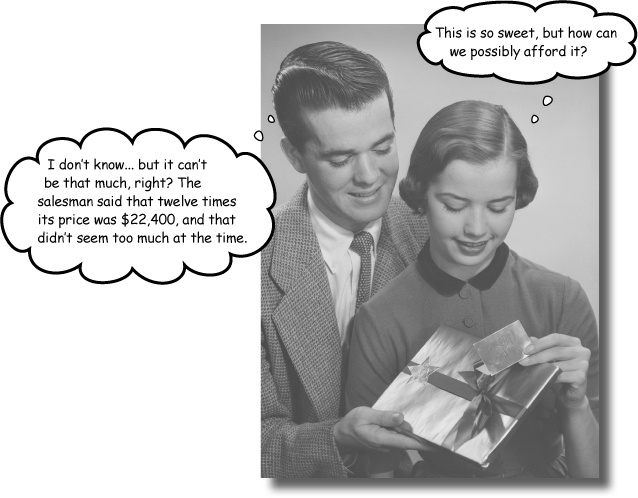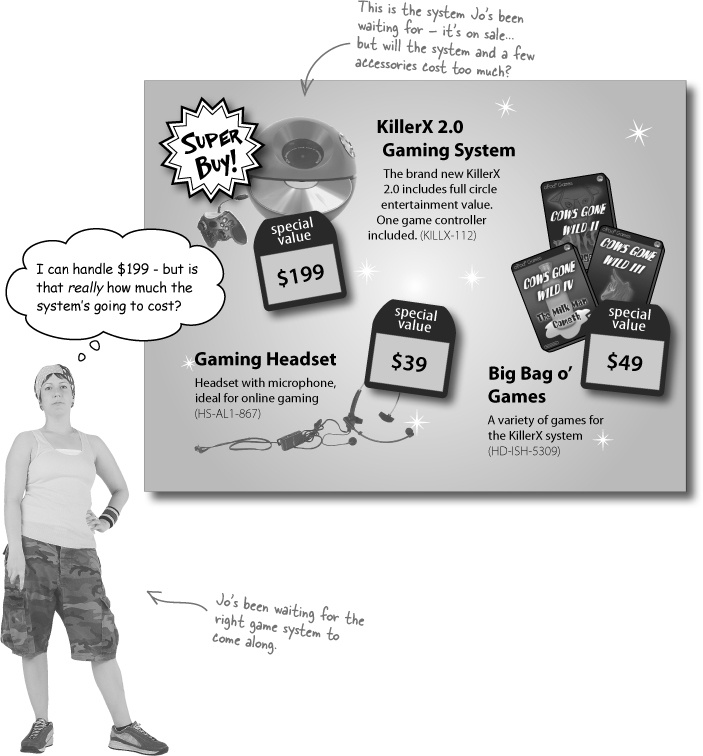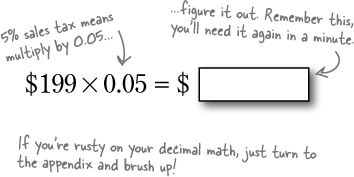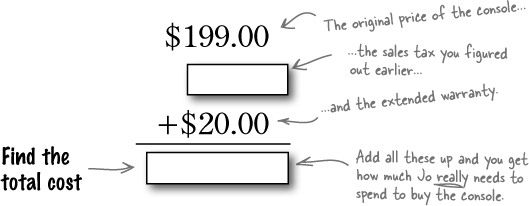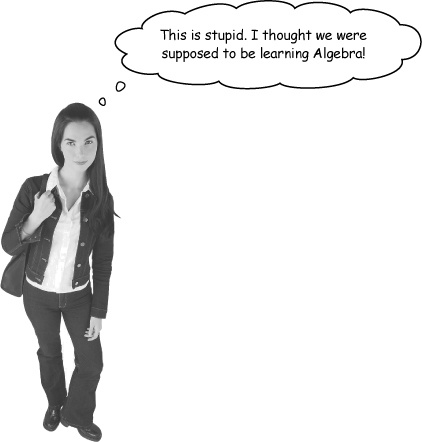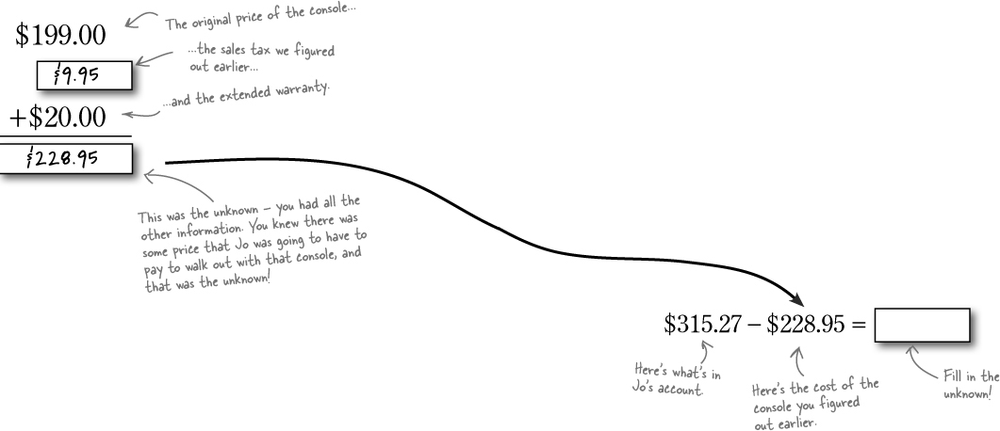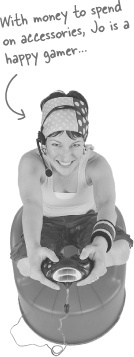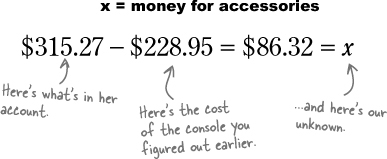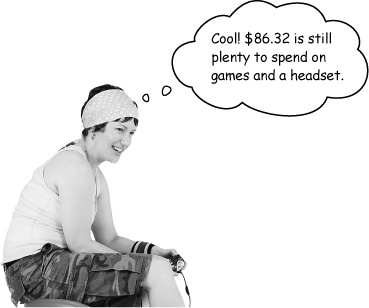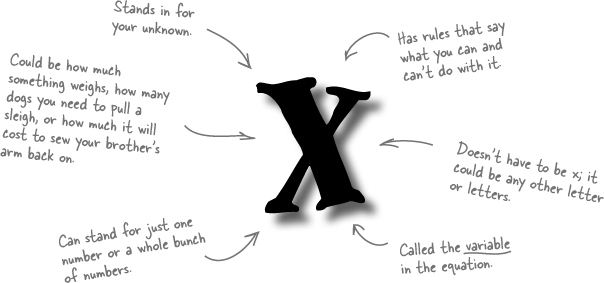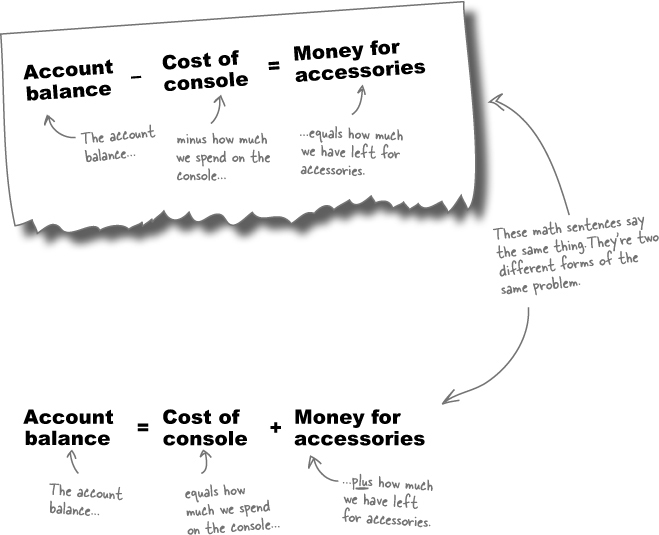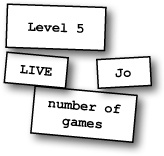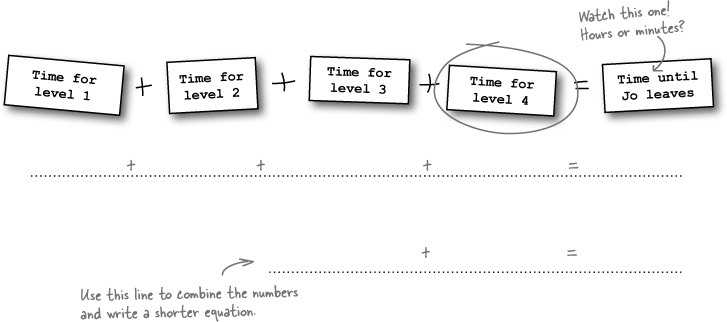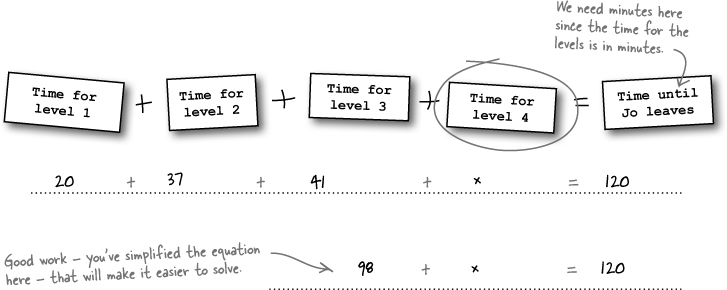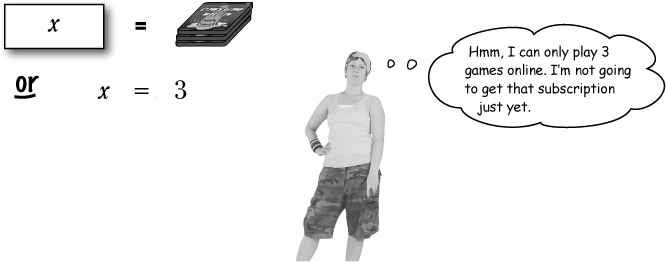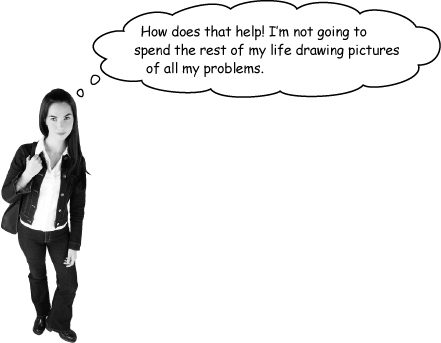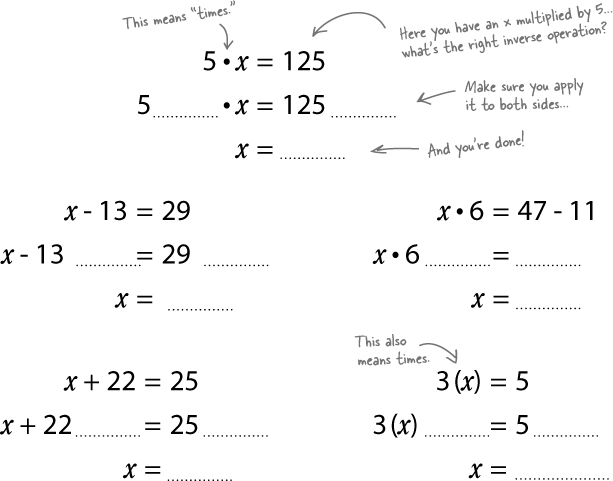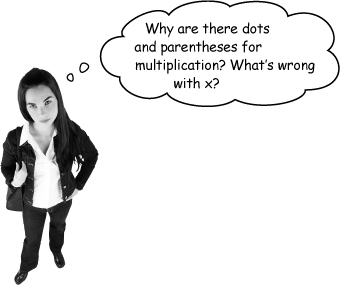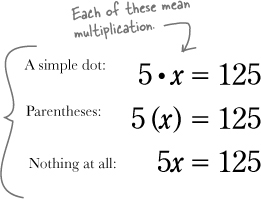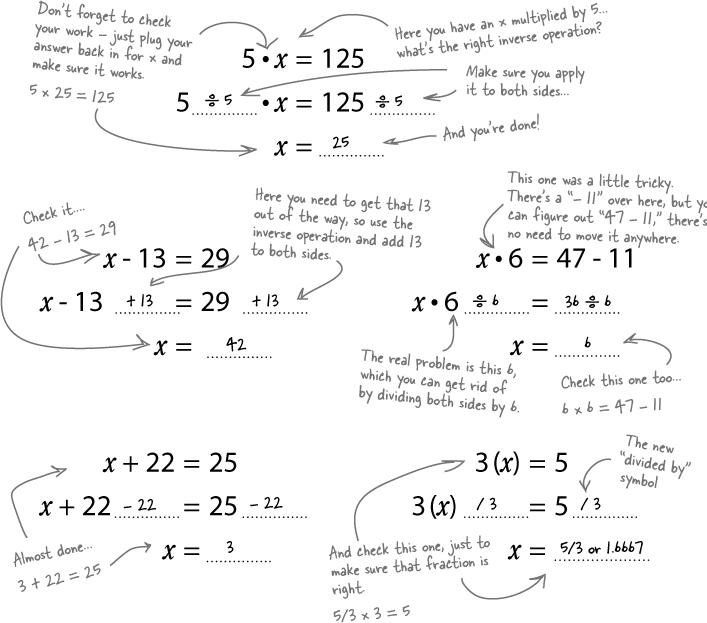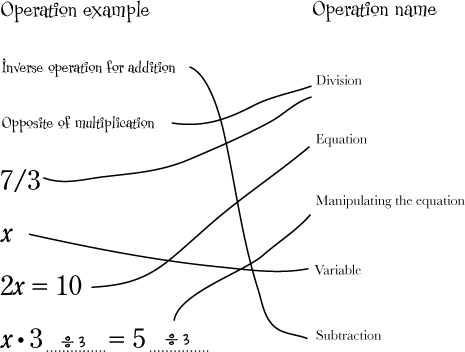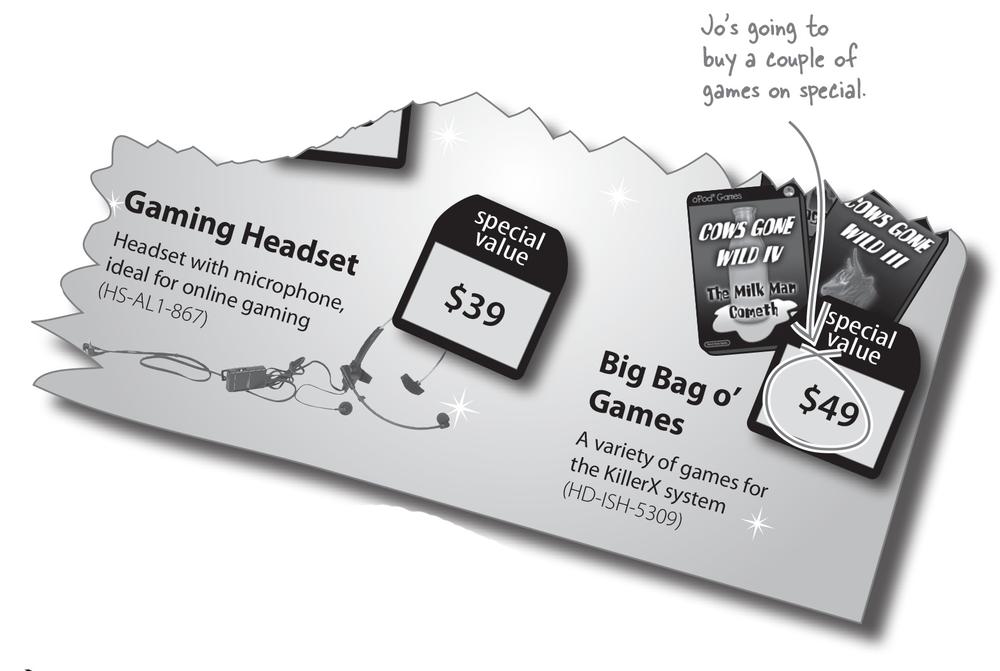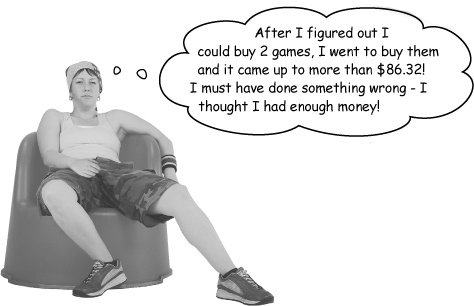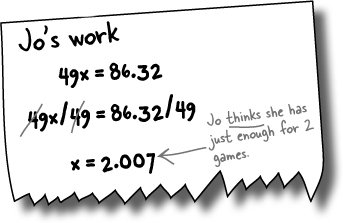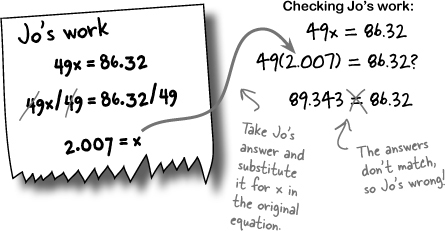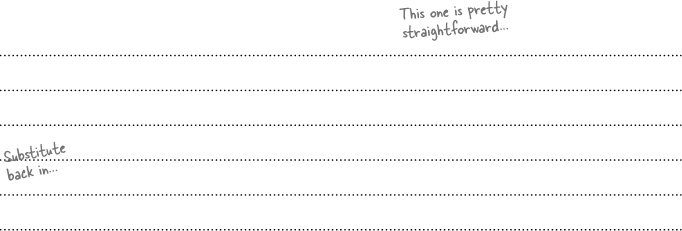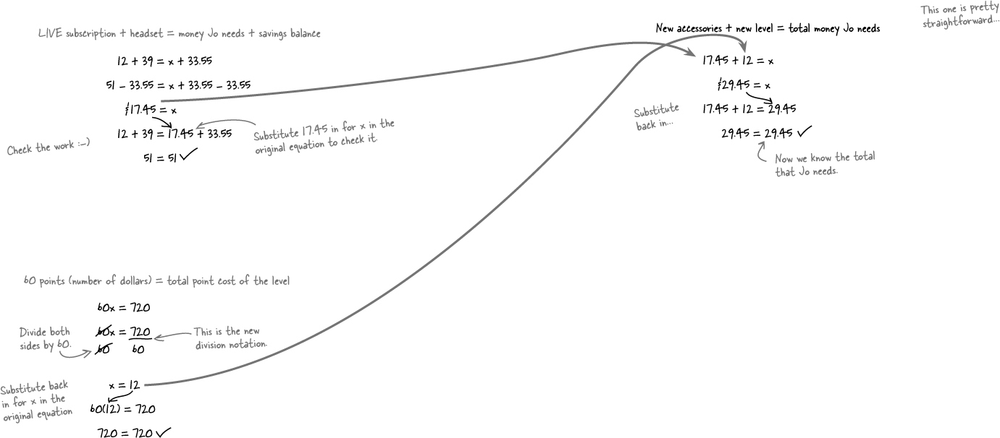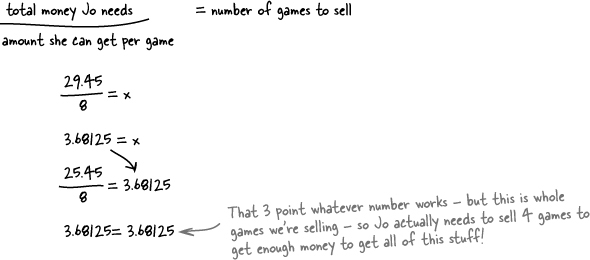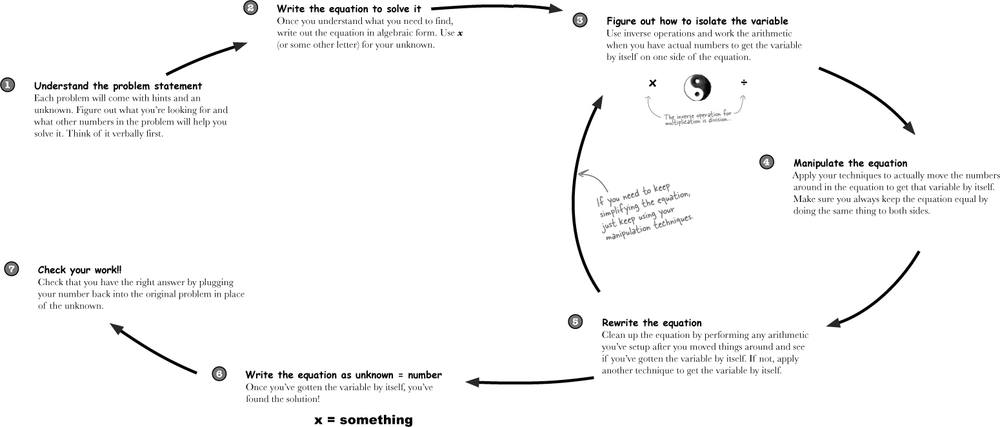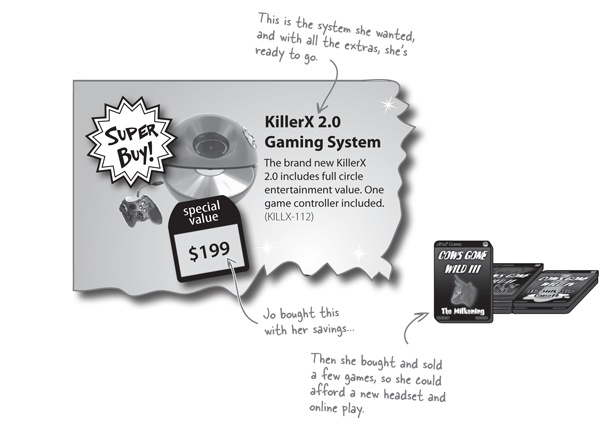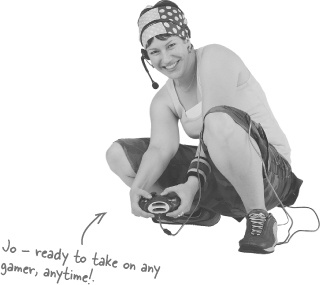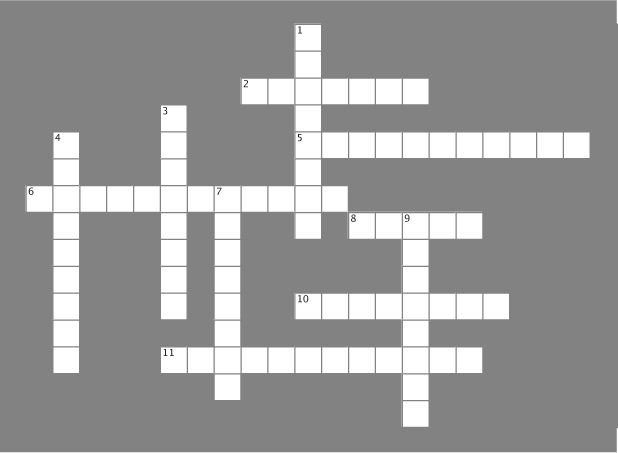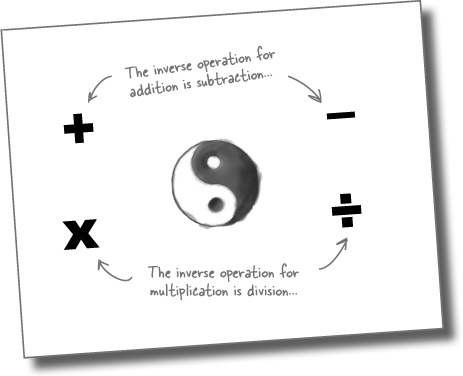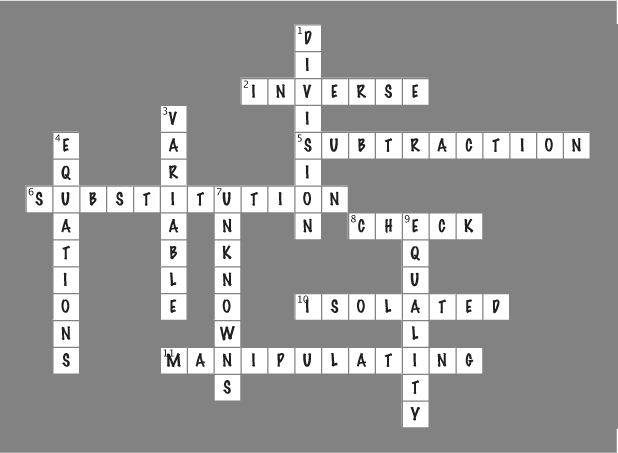Chapter 1. What is Algebra?: Solving for unknowns...
Do you ever wish you knew more than know? Well, that’s what Algebra’s all about: making unknowns known. By the time you’re through this first chapter, you’ll already have a handle on X being a lot more than a mark where treasure’s buried. You’ll get a handle on equations, keeping both sides of an equation balanced, and why solving for unknowns really isn’t that big of a deal. What are you waiting for? Go on and get started!
It all started with a big gaming sale
Jo has been watching the game system battles for a while now and has finally decided on the one she wants. Her favorite system’s on sale this week, and she’s ready to buy. But can she afford it? That’s where she needs a little help from you.
What does a system really cost?
When you buy things—especially expensive electronic things—there are lots of pieces that add into the price besides just the number on a sales flyer: sales tax, an extended warranty, shipping and handling, etc. So what will a KillerX system really cost?
There’s tax on the system...
The base price of the system is $199. After that, we need to think about taxes, which are 5%. Let’s figure out how much Jo’ll have to pay in taxes:
... and the extended warranty, too.
Jo’s about to spend $199 on a game machine, and she wants to purchase an extended warranty plan for an additional $20. Let’s put that in the price, too. What price will Jo need to pay?
Figuring out the total wasn’t just addition! It was solving for an unknown—and that’s Algebra. In this case the unknown was how much everything was going to cost.
Algebra is about solving for unknowns
Algebra is about finding the missing information that you’re looking for by using the information you already have. The unknown could be the cost of a car loan, the quantity of soda you need, or how high you can throw a water balloon. If you don’t know it, it’s an unknown.
All the other things that you’ll learn in Algebra are just ways to jiggle things around to help you find a piece of missing information. There are rules about when you can multiply things or when you can bump something from one side of an equals sign to another, but at the end of the day, they’re all just tricks to help you find that missing piece of information you’re looking for.
Jo’s got more unknowns
So Jo knows how much it will take to buy an awesome gaming system, including an extended warranty. But she still doesn’t have any games... or another controller... or a headset.
Jo started with $315.27 in her bank account. Now that she’s paid for the console, how much can Jo spend on accessories? Let’s start by writing this out in words:
We know how much the console costs ($228.95), and we know how much Jo has in her account ($315.27). Now just fill in the blanks, and we can figure out Jo’s accessory budget:
Solving for any unknown is Algebra.
X marks the spot unknown
x is just a user-friendly stand-in for the unknown box we used earlier. x is easier to write and it’s what you’re looking for when you solve an equation. The unknown in any given situation is called a variable. In the real world, problems present themselves every day; translating them into mathematical equations allows you to solve them.
Equations are math sentences
Equations, like the one you used earlier to figure out how much Jo could spend on accessories, are just math sentences. They’re a mathematical way of saying something. So when we talked about Jo’s account balance, we were actually using an equation:
Our equation means “The account balance minus how much we spend on the console equals how much we have left for accessories.” So, that means that the account balance must equal the cost of the console plus the money for accessories. If we write that sentence as an equation it looks like this:
Equations can be rearranged like sentences.
Both sentences mean the same thing; they’re just phrased differently. Over the next few pages, you’ll learn how to rearrange math sentences and make sure that you don’t change any values.
Now SOLVE for the unknown
Jo is trying to decide if it’s worth it for her to buy a LIVE subscription. She has 10 games, and 7 of them don’t have any online play. How many does she have that can be played online? Does it make sense for her to buy the subscription?
What we really care about here is what x is—the unknown number of games. We don’t really care about the seven games on the left side of the equation. In fact, we can get rid of that seven as long as we make sure we do the same thing to both sides of the equation.
An equals sign means that both sides are the same. So if we take 7 away from one side, we have to do the same thing to the other side of the equation:.
So here’s what we have left:
You don’t need pictures to do algebra.
What you need is a way to use the operations that you already know (addition, subtraction, multiplication, and division) to solve equations.
The tricky part? You must preserve the equality. Equality means the same. When you do something to one side of the equation, you have to do the same thing to the other side of the equation.
Here’s another way to look at Jo’s online problem without pictures:
When you get x all by itself, you’re isolating the variable. That’s the most important part of solving an equation. Isolating the variable means you’ve gotten the variable by itself on the left side of the equation and everything else stacked up over on the right. If you can isolate a variable, then you’ve solved the equation—the answer just pops out, like x = 3.
Knowing that your goal is to isolate the variable means that you know which numbers to move away from the left side. Since you’re trying to get x alone, that means that you move the seven, not the 10!
So which operation do you use when?
The opposite of addition is subtraction. So, if some number is being added on one side of the equation, and you want to move that number to the other side, you can subtract that number from both sides. The math term that describes opposite operations is inverse operations.
The basic math operations are addition, subtraction, multiplication, and division. An inverse operation is the operation that undoes an operation (like addition undoes subtraction). Inverse operations let you shift a number or variable from one side of the equation to the other by “undoing” that number on one side of an equation.
When you want to solve an equation:
Look at the equation and figure out what numbers to move.
Using Jo’s equation, we had to get rid of the 7. That’s because we’re trying to isolate the variable, the x.
Figure out which operation to use.
You need to use the inverse operation for the number to remove it. For a subtracted number, add. For a divided number, multiply, and so on.
Preserve equality.
Whatever you decide to do to one side of the equation, you must do to the other. That keeps the equation the same.
Brain Power
There are other inverse operations out there. Can you think of other operation pairs that work?
Whoever thought it was a good idea to use x to mean the typical unknown apparently didn’t mind the confusion it might cause with the multiplication sign, x. However, lots of other people did.
They gave up on using x for multiplication and came up on with a few easier to read options:
Jo is ready to accessorize!
Jo figured out that she had $86.32 left in her account for accessories. She decided that she wants to get more games and not worry about the headset just yet.
Jo did some quick Algebra to figure out how many games she can buy:
Cecking Checking your work...
You’ll find as you go forward with Algebra that the problems become more complicated, and it’s pretty easy to make a mistake. Jo didn’t divide correctly, and that got her! Checking your work doesn’t mean just looking over what you did. It also means using a specific technique called substitution.
Substitution uses your solution in the original equation
Substitution means putting something in for something else. A substitute teacher is in the place of a regular teacher, right? To check your work, you substitute in the answer you found for the variable in the original equation.
Substitution is a process that can be used not just for checking your work, but for other things too. When we get to more complex equations, and equations with more than one variable, you’ll want to use substitution as part of the solving process.
Equation training
Let’s put all your mad equation solving skills together to solve a real world problem using Algebra:
Jo has an awesome setup!
After a trip to sell off 4 games and buy a headset, Jo signed into LIVE and bought that new level, and she is ready to play!
Jo’s about to spend hours on her new game—but when she’s done, it’ll be easy to figure out what game she can afford next!
Get Head First Algebra now with the O’Reilly learning platform.
O’Reilly members experience books, live events, courses curated by job role, and more from O’Reilly and nearly 200 top publishers.
